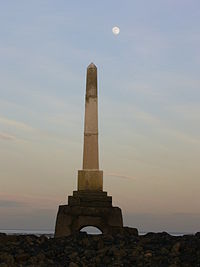- London Stone (riparian)
-
For the stone used to mark the centre of London, see London Stone.
London Stone is the name given to a number of boundary stones which stand beside rivers in south east England.
Contents
History
Until 1350, the English Crown held the right to fish the rivers of England and charged duties on those people it licenced to fish. In 1197 King Richard I, in need of money to finance his involvement in the Third Crusade, sold the rights over the lower reaches of the River Thames to the City of London. Marker stones were erected to indicate the limit of the City's rights.
In Victorian times, the Lord Mayor would come in procession by water and touch the Staines stone with a sword to re-affirm the City's rights.
Control of the river passed in turn from the City to the Thames Conservancy, the Port of London Authority (below Teddington) and finally to the Environment Agency.
Staines
In medieval times before the canalisation of the Thames, Staines was the highest point to which tides reached. It was also the next bridge upstream from London Bridge, a distance of 31 km as the crow flies. The London Stone here marked the upstream limit of the City's rights. It was originally erected in 1285 near Staines Bridge following the grant of a charter by Edward I.[1] The original location is confirmed by the semi-circular indentations (on the right hand face in the photo). These were created by the tow ropes of horse-drawn boats rubbing against the stone.
In 1750 (approx.) the stone was moved about 500 metres upstream to a site at grid reference TQ028718 on the north bank of the river in the Lammas Pleasure Ground. Later the stone was moved to the Old Town Hall Arts Centre, Market Square, Staines and a replica was placed in the Pleasure Ground. It is now in the museum attached to Staines Library.[2]
The stone proper is only about 60 cm high. Any inscription it may once have had has worn away. It stands on a plinth inscribed with the names of various City worthies who may have been involved in its 1750 move, all of which is now a Grade II listed structure.[3] Martin Nail included the Stone as No. 83 in his list of Coal and Wine Tax Posts since it happens to stand on the line of route of the posts.
Yantlet Creek
The downstream limit of the City's rights is about 54 km as the crow flies from London Bridge and is marked on both banks of the river. On the south bank the marker is the London Stone which stands at grid reference TQ860786 beside the mouth of Yantlet Creek on the Isle of Grain.
The overall height of the monument is about 8 metres. The main column has an inscription, now illegible. The plinth on which it stands has an inscription listing various worthy gentlemen who were probably involved in the re-erection of the stone in Victorian times. They include Horatio Thomas Austin and Warren Stormes Hale, sometime Lord Mayor and founder of the City of London School.
Crow Stone
The marker on the north bank is almost due north of Yantlet Creek and is called the Crow Stone (also known as Crowstone or City Stone). It stands at grid reference TQ857852 on the mud opposite the end of Chalkwell Avenue, Southend-on-Sea (two nearby roads are called Crowstone Avenue and Crowstone Road). It was erected in 1837 and replaced a smaller stone, dating from 1755. The older stone was removed to Priory Park in Southend where it remains today. It is likely that there has been a marker on this site and at Yantlet since 1285.[1]
The line between the Crow Stone and the London Stone, Yantlet Creek is known as the 'Yantlet Line' and is used as the boundary for various things including the limit of jurisdiction of the Port of London Authority.
Upnor
Two London Stones stand at grid reference TQ762712 between the Arethusa Venture Centre and the River Medway in Lower Upnor. The older, smaller stone is dated 1204 and carries on its rear the inscription "God preserve the City of London".[4] Apart from that the inscriptions of both stones are merely the names of various Lord Mayors and years.
References
- ^ a b Article from the Essex Countryside magazine, 1965
- ^ Spelthorne Borough Council interpretation board in Lammas Pleasure Ground
- ^ Listing reference
- ^ Image description at Geograph
External links
- Pages on geograph for: London Stone, Staines, the Crow Stone, London Stone, Yantlet Creek
- Google search for "Yantlet Line"
- The PLA page of thames.me.uk
Categories:- History of the City of London
- Spelthorne
- Geography of Kent
- History of Kent
- Islands of the River Thames
- Southend-on-Sea
- Medway
- Grade II listed buildings in Surrey
Wikimedia Foundation. 2010.



